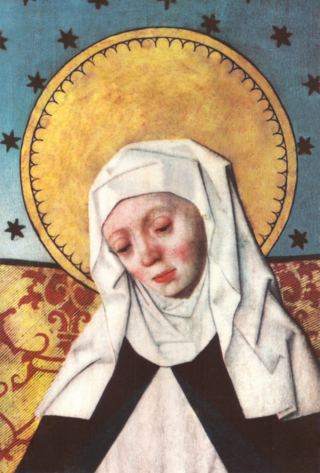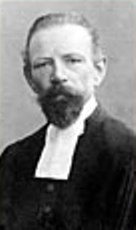Related Research Articles

Bridget of Sweden, OSsS, born Birgitta Birgersdotter and also known as Birgitta of Vadstena, was a Swedish Catholic mystic and the founder of the Bridgettines. Outside of Sweden, she was also known as the Princess of Nericia and was the mother of Catherine of Vadstena.
Neo-Lutheranism was a 19th-century revival movement within Lutheranism which began with the Pietist-driven Erweckung, or Awakening, and developed in reaction against theological rationalism and pietism.

The term Evangelical Catholic is used in Lutheranism, alongside the terms Augsburg Catholic or Augustana Catholic, with those calling themselves Evangelical Catholic Lutherans or Lutherans of Evangelical Catholic churchmanship stressing the catholicity of historic Lutheranism in liturgy, beliefs, practices, and doctrines. Evangelical Catholics teach that Lutheranism at its core "is deeply and fundamentally catholic". The majority of Evangelical Catholic Lutheran clergy and parishes are members of mainstream Lutheran denominations.

High church Lutheranism is a movement that began in 20th-century Europe and emphasizes worship practices and doctrines that are similar to those found within Roman Catholicism, Eastern Orthodoxy and Anglo-Catholicism. In the more general usage of the term, it describes the general high church characteristics of Lutheranism in Nordic and Baltic countries such as Sweden, Finland, Estonia and Latvia. The mentioned countries, once a part of the Swedish Empire, have more markedly preserved Catholic traditions.
The Liturgical Movement was a 19th-century and 20th-century movement of scholarship for the reform of worship. It began in the Catholic Church and spread to many other Christian churches including the Anglican Communion, Lutheran and some other Protestant churches.
Lutheranism as a religious movement originated in the early 16th century Holy Roman Empire as an attempt to reform the Catholic Church. The movement originated with the call for a public debate regarding several issues within the Catholic Church by Martin Luther, then a professor of Bible at the young University of Wittenberg. Lutheranism soon became a wider religious and political movement within the Holy Roman Empire owing to support from key electors and the widespread adoption of the printing press. This movement soon spread throughout northern Europe and became the driving force behind the wider Protestant Reformation. Today, Lutheranism has spread from Europe to all six populated continents.
Friedrich Heiler was a German theologian and historian of religion.

Heinrich Hansen was a German Lutheran theologian and the father of the Lutheran High Church movement in Germany.

The Evangelical Lutheran Church in Bavaria is a Lutheran member church of the Protestant Church in Germany in the German state of Bavaria.

The Hochkirchliche Vereinigung Augsburgischen Bekenntnisses is a Lutheran High Church organisation in Germany. It was founded in Berlin in October 1918, inspired by the High Church theses Stimuli et Clavi (1917) by Heinrich Hansen. Later it was greatly influenced by the Evangelical Catholic theology of professor Friedrich Heiler.
Berneuchen Movement is part of the Lutheran Liturgical movement in Germany. It originates from German Youth Movement.
Bund für evangelisch - katholische Wiedervereinigung e.V. is a German Lutheran High Church organisation, founded in 1960.
The Evangelische Michaelsbruderschaft (EMB) (Evangelical Brotherhood of St. Michael) is a German religious Brotherhood belonging to Berneuchen Movement as a part of Lutheran Liturgical Movement.

Helmut Friedbert Richard Siegfried Echternach was a German Lutheran theologian and pastor, and one of the leaders of the Lutheran High Church Movement in Germany.
Hochkirchliche St. Johannes-Bruderschaft (SJB) is a German High Church Lutheran religious society for men and women under the patronate of John the Apostle within the Hochkirchliche Vereinigung. It has about 100 members in Germany, Netherlands, Austria and Czech Republic. It is headed by Apostolischer Vorsteher +Innocenz Konrad Schrieder.
Lutheranism is a major branch of Protestantism that identifies primarily with the theology of Martin Luther, the 16th-century German monk and reformer whose efforts to reform the theology and practices of the Catholic Church launched the Reformation in 1517. Lutheranism subsequently became the state religion of many parts of Northern Europe, starting with Prussia in 1525.

Protestantism is a branch of Christianity that emphasizes justification of sinners by grace through faith alone, the priesthood of all believers, and the Bible as the sole infallible source of authority for Christian faith and practice. The five solae summarize the basic theological beliefs of mainstream Protestantism.

The Evangelical-Lutheran Church in Württemberg is a Lutheran member church of the Protestant Church in Germany in the German former state of Württemberg, now part of the state of Baden-Württemberg.

The Church of Lippe is a Reformed (Calvinist) member church of the Protestant Church in Germany that covers what used to be the Principality of Lippe.
The Protestant Church of the Augsburg Confession of Alsace and Lorraine is a Lutheran church of public-law corporation status in France. The ambit of the EPCAAL comprises congregations in Alsace and the Lorrain Moselle department.
References
- ↑ (in German) "Diese 1921 gegründete Gemeinschaft geht auf Impulse Freidrich Heilers zurück" http://www.kommunitaeten.de/komm/kom82.htm Archived 2007-02-11 at the Wayback Machine
- ↑ Meland, Bernard E. (1933). "Friedrich Heiler and the High Church Movement in Germany". The Journal of Religion . 13 (2). University of Chicago Press: 139–49. doi:10.1086/481292. ISSN 1549-6538. JSTOR 1196857. S2CID 170415895.
- ↑ Swidler, Leonard J.: The Ecumenical Vanguard: The History of the Una Sancta Movement Archived 2007-08-13 at the Wayback Machine
- PROTESTANT COMMUNITIES AND ORDERS Broken Link